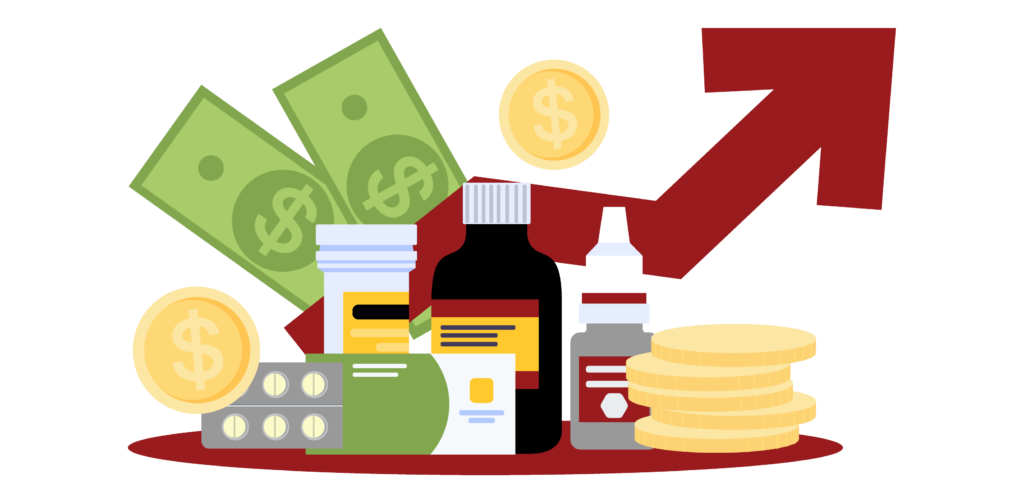
White Papers | Journal Articles | Videos and Data Visualizations | Perspectives | Testimony | Events
White Papers
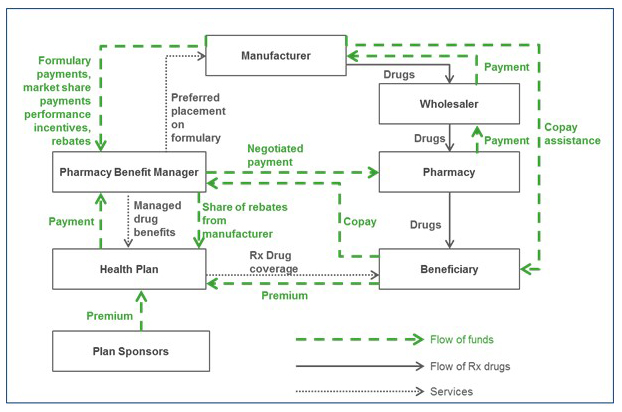
U.S. Consumers Overpay for Generic Drugs
May 31, 2022 | By Erin Trish, Karen Van Nuys and Robert Popovian
Growing evidence shows that U.S. consumers often overpay for generics as pharmacy benefit managers game opaque and arcane pricing practices to pad profits. Greater transparency across the generic prescription distribution chain and policies to spur competition and deter anticompetitive practices can reduce generic drug costs.
How Would Sharing Rebates at the Point-Of-Sale Affect Beneficiary Cost-Sharing in Medicare Part D?
March 17, 2020 | By Erin Trish, Katrina Kaiser and Geoffrey Joyce
If cost-sharing were based on net price it would provide meaningful financial relief to many Part D beneficiaries.
The Association Between Drug Rebates and List Prices
February 11, 2020 | By Neeraj Sood, Rocio Ribero, Martha Ryan and Karen Van Nuys
Drug rebates and list prices are positively correlated: On average, a $1 increase in rebates is associated with a $1.17 increase in list price.
State Drug Pricing Transparency Laws: Numerous Efforts, Most Fall Short
September 25, 2019 | By Martha Ryan and Neeraj Sood
166 recently enacted prescription drug pricing laws were analyzed to identify those that contained price transparency measures. Of these, 35 bills in 22 states include a transparency component, but only 7 were deemed to be informative.
Overpaying for Prescription Drugs: The Copay Clawback Phenomenon
March 12, 2018 | By Karen Van Nuys, Geoffrey Joyce, Rocio Ribero and Dana Goldman
In 2013, almost one-quarter of filled pharmacy prescriptions (23%) involved a patient copayment that exceeded the average reimbursement paid by the insurer by more than $2.00.
Prescription Drug Copayment Coupon Landscape
February 7, 2018 | By Karen Van Nuys, Geoffrey Joyce, Rocio Ribero and Dana Goldman
The researchers examined copay coupon availability for the top 200 drugs (by spending) in 2014. Of these, 132 were brand drugs, and 90 of those had coupons available.
Reining in Pharmaceutical Costs
January 12, 2018 | By Karen Van Nuys, Dana Goldman and Ian Spatz
Policymakers should prioritize four actions that could engender more cooperation and improve health over the long term.
Flow of Money Through the Pharmaceutical Distribution System
June 6, 2017 | By Neeraj Sood, Tiffany Shih, Karen Van Nuys and Dana Goldman
For every $100 spent at retail pharmacies, about $17 compensates for direct production costs, $41 accrues to the manufacturer, and $41 accrues to intermediaries in the distribution system.
Journal Articles
Cost Sharing for Preferred Branded Drugs in Medicare Part D
February 14, 2025 | By Erin Trish, Barbara Blaylock and Karen Van Nuys | JAMA
The share of stand-alone prescription drug plans using coinsurance for preferred brand name drugs surged in recent years, exposing more patients to list prices that are often artificially inflated.
Pharmacy Benefit Manager Market Concentration for Prescriptions Filled at US Retail Pharmacies
September 10, 2024 | By Dima M. Qato, Karen Van Nuys and Yugen Chen | JAMA
A few pharmacy benefit managers dominate each of the payer markets, and the three biggest PBMs appear to be targeting different markets.
Medicare Part D Plans Greatly Increased Utilization Restrictions On Prescription Drugs, 2011–20
March 4, 2024 | By Geoffrey Joyce, Jiafan Chen, Karen Van Nuys and Barbara Blaylock | Health Services Research
Part D plans became significantly more restrictive over time, rising from an average of 31.9 percent of compounds restricted in 2011 to 44.4 percent restricted in 2020.
Disadvantaging Rivals: Vertical Integration in the Pharmaceutical Market
August 14, 2023 | By Abby E. Alpert, Neeraj Sood and Charles Gray | National Bureau of Economic Research
Premiums of Part D beneficiaries enrolled in a plan that is vertically integrated with a PBM increased from 30% to 80% between 2010 and 2018.
Pharmacy Switching in Response to Preferred Pharmacy Networks in Medicare Part D
March 17, 2022 | By Erin Trish, Geoffrey Joyce and Jianhui Xu | Health Services Research
Preferred pharmacy networks caused a moderate shift on average towards preferred pharmacies among unsubsidized beneficiaries, although stronger financial incentives correlated with more switching.
Estimation of the Share of Net Expenditures on Insulin Captured by US Manufacturers, Wholesalers, Pharmacy Benefit Managers, Pharmacies, and Health Plans From 2014 to 2018
November 5, 2021 | By Karen Van Nuys, Rocio Ribero, Martha Ryan and Neeraj Sood | JAMA Health Forum
One of the most comprehensive looks at the insulin distribution chain and shows which players are profiting, and by how much, from selling insulin.
Comparison of Spending on Common Generic Drugs by Medicare vs Costco Members
July 27, 2021 | By Erin Trish, Rocio Ribero, Karen Van Nuys and Geoffrey Joyce | JAMA Internal Medicine
A study comparing Medicare Part D prescription drug prices with those paid by Costco members finds that the federal government overpaid on roughly half of the most common generic medicines in 2018.
Do Companies in the Pharmaceutical Supply Chain Earn Excess Returns?
January 4, 2021 | By Neeraj Sood, Karen Mulligan and and Kimberly Zhong | International Journal of Health Economics and Management
Public policies that promote competition in all areas of the pharmaceutical supply chain are important avenues for curtailing drug spending.
Analysis of State-Level Drug Pricing Transparency Laws in the United States
September 25, 2019 | By Martha Ryan and Neeraj Sood | JAMA Network Open
A study analyzing state drug price transparency laws to assess their potential to improve transparency in the drug supply system.
Insulin Access and Affordability Working Group: Conclusions and Recommendations
May 11, 2018 | By ADA Working Group | Diabetes Care
The average list price of insulin has skyrocketed in recent years, nearly tripling between 2002 and 2013. The reasons for this increase are not entirely clear but are due in part to the complexity of drug pricing in general and of insulin pricing in particular. Schaeffer researchers were part of the ADA working group that looked into this issue.
Frequency and Magnitude of Co-payments Exceeding Prescription Drug Costs
March 13, 2018 | By Karen Van Nuys, Goeffrey Joyce and Rocio Ribero | JAMA
Twenty-three percent of prescription claims analyzed involved a copay overpayment.
Videos and Data Visualizations
The Price of Insulin, Explained
February 6, 2022
This animation explains research published in JAMA Health Forum by Schaeffer Center experts that offers one of the most comprehensive looks at the insulin distribution chain and shows which players are profiting, and by how much, from selling insulin.
Untangling the Price of Insulin
November 5, 2021
In this data visualization, Schaeffer experts combined data from many sources, including reports from state governments that recently passed drug pricing transparency initiatives, to gain greater insight into the economics of the insulin drug distribution system.
Data Visualization: State Drug Transparency Laws
September 25, 2019
This interactive map and table summarizes the state 35 drug pricing bills identified to have a transparency component. Schaeffer experts analyzed 166 prescription drug pricing laws enacted between 2015 and 2018 to identify those that contained price transparency measures that could improve understanding of the economic forces driving drug price increases.
Prescription Copay Clawbacks, Explained
August 13, 2018
This animation explained research published in JAMA by Schaeffer Center experts that analyzes the frequency and magnitude of copay clawbacks, the phenomenon when a patient’s copayment for a prescription drug exceeds the cost of the drug.
Perspectives
A Patient-Focused, Evidence-Driven Approach to PBM Reform
July 22, 2024 | By Karen Van Nuys, Stephanie Hedt, Geoffrey Joyce, Darius Lakdawalla, Barry Liden, Neeraj Sood and Erin Trish
As policymakers consider reforms to the prescription drug supply chain, they should keep five principles in mind to ensure better outcomes for patients.
Drug Middlemen in the Hot Seat
July 17, 2024 | Q&A with Erin Trish
Solving issues in the PBM market is an important component of making meaningful differences in what patients pay for drugs.
A Spoonful of Sugar Makes the Medicine Go Down
January 30, 2024 | By Geoffrey Joyce
The lack of transparency and inability of plan sponsors to assess how much pharmacy benefit managers generate in savings and how much they retain for themselves is the root issue.
How the Secrecy of Middlemen Inflates Drug Prices
October 14, 2023 | By Neeraj Sood and Karen Van Nuys | The Hill
Drug costs can be driven down if market forces are allowed to target those profits, but first everyone needs to know what is being charged, and by whom to whom.
Ending Health Insurance for Generic Drugs Would Save Patients Money
March 28, 2023 | By Erin E. Trish and Karen Van Nuys | The Washington Post
Eliminating insurance for generics might make patients nervous at first, but the payoff would be stable and affordable prices.
Eli Lilly Is Cutting Insulin Prices and Capping Copays at $35 – 5 Questions Answered
March 3, 2023 | By Dana Goldman and Karen Van Nuys | The Conversation
Insulin prices are the result of a complex set of negotiations between manufacturers and pharmacy benefit managers, which act on behalf of insurers. The three largest – CVS Caremark, Express Scripts and Optum Rx – handle about 80% of all prescriptions.
The Cantwell-Grassley PBM Bill Is Much Needed But More Can Be Done
July 12, 2022 | By Neeraj Sood and Karen Van Nuys | Health Affairs Forefront
Senators Maria Cantwell and Chuck Grassley introduced legislation that would curtail pharmacy benefit manager practices that are driving up drug prices. Schaeffer Center experts Neeraj Sood and Karen Van Nuysh write in a new Health Affairs Forefront article that the proposed reforms are a helpful start, but could go further in addressing the lack of competition in the U.S. market where the top three PBMs control 80%.
PBMs Are Inflating the Cost of Generic Drugs. They Must Be Reined In
July 5, 2022 | By Erin Trish, Karen Van Nuys, and Robert Popovian | STAT First Opinion
Anti-competitive practices and a lack of transparency in the generic drug market allow pharmacy benefit managers to profit off patients and payers.
Who Is Really Driving Up Insulin Costs?
April 18, 2022 | By Karen Van Nuys, Erin Trish and Neeraj Sood | MedPage Today
In the long term, capping insulin payments at $35 a month is just shuffling the deck rather than changing the game of insulin costs.
Middlemen, Not Drug Companies, Are Pushing Up Insulin Prices, and Congress Doesn’t Have the Right Plan to Fight Back
November 19, 2021 | By Karen Van Nuys and Neeraj Sood | MarketWatch
Congress should take advantage of the current political climate and start reining in the intermediaries in the drug distribution system.
Insurer Formularies Complicate the Adoption of Biosimilar Cancer Therapies
April 8, 2021 | By Alice Chen, Priya Bhanot, Rocio Ribero, Rita Shane and Karen Van Nuys | Health Affairs Blog
Insurer preferences for biologic and biosimilar drugs add cost and complicate the work of hospital pharmacists and physicians.
Sharing Drug Rebates With Medicare Part D Patients: Why And How
September 15, 2020 | By Steven M. Lieberman, Paul Ginsburg and Erin Trish | Health Affairs
The percentage of total Medicare Part D drug spending offset by rebates on branded drugs increased from 11% in 2010 to 25% in 2018.
Who Pays in Medicare Part D? Giving Plans More Skin in the Game
November 20, 2019 | By Erin Trish, Paul Ginsburg, Geoffrey Joyce and Dana Goldman | The New England Journal of Medicine
As U.S. policymakers debate proposals for reforming the prescription-drug marketplace, they should recognize the need to update the Medicare Part D benefit design to give the private plans that largely administer it more skin in the game.
Ending Drug Rebates Will Increase Medicare Part D Premiums. Most Seniors Will Be Insulated From It
February 19, 2019 | By Erin Trish and Dana Goldman | STAT
Due to subsidies, ending drug rebates will likely marginally impact seniors.
Surprise! Trump Might Actually Lower Drug Prices
August 28, 2018 | By Dana Goldman and Anupam Jena | The Washington Post
Health and Human Services Secretary Alex Azar wants to end kickbacks in the pharmacy distribution chain that are costing Medicare and taxpayers billions of dollars.
Follow the Money to Understand How Drug Profits Flow
December 15, 2017 | By Neeraj Sood, Dana Goldman and Karen Van Nuys | STAT
Only by following the money will a clear understanding emerge of the economic forces roiling the industry and driving price increases.
Testimony and Comment Letters
Testimony on the Role of Pharmacy Benefit Managers
September 11, 2024
Karen Van Nuys spoke to the House Judiciary Subcommittee on the Administrative State, Regulatory Reform, and Antitrust about potential reforms to PBM practices that lawmakers should consider.
Testimony on Pharmacy Benefit Managers and the Prescription Drug Supply Chain
March 30, 2023
Karen Van Nuys spoke to the Senate Finance Committee about the role PBMs play in the pharmaceutical distribution system.
Testimony on Pharmacy Benefit Managers and the Prescription Drug Supply Chain
March 30, 2023
Karen Van Nuys spoke to the Senate Finance Committee about the role PBMs play in the pharmaceutical distribution system.
Testimony on Bringing Transparency and Accountability to Pharmacy Benefit Managers
February 16, 2023
Erin Trish spoke at the Senate Committee on Commerce, Science, & Transportation about the complex and influential role that PBMs play in the pharmaceutical distribution system.
Testimony on Bringing Transparency and Accountability to Pharmacy Benefit Managers
February 16, 2023
Erin Trish spoke at the Senate Committee on Commerce, Science, & Transportation about the complex and influential role that PBMs play in the pharmaceutical distribution system.
Comments to the Federal Trade Commission on Pharmacy Benefit Managers
May 25, 2022 | By Geoffrey Joyce, Darius Lakdawalla, Karen Mulligan, Neeraj Sood, Erin Trish, and Karen Van Nuys
An FTC investigation of anticompetitive and harmful PBM business practices could help spur a more efficient and equitable pharmaceutical distribution system by: (1) increasing access to lifesaving medications for patients who need them, and (2) sharing economic surplus in a way that ensures both near-term affordability and ongoing healthcare innovation.
Comments to the Federal Trade Commission on Pharmacy Benefit Managers
May 25, 2022 | Geoffrey Joyce, Darius Lakdawalla, Karen Mulligan, Neeraj Sood, Erin Trish and Karen Van Nuys
PBMs play a central role in the economic system that distributes and pays for life-saving drugs in the United States. Unfortunately, evidence indicates they leverage their position to extract profits from other distribution system participants in ways that are detrimental to patients, payers, and the drug innovation system more broadly.
Events
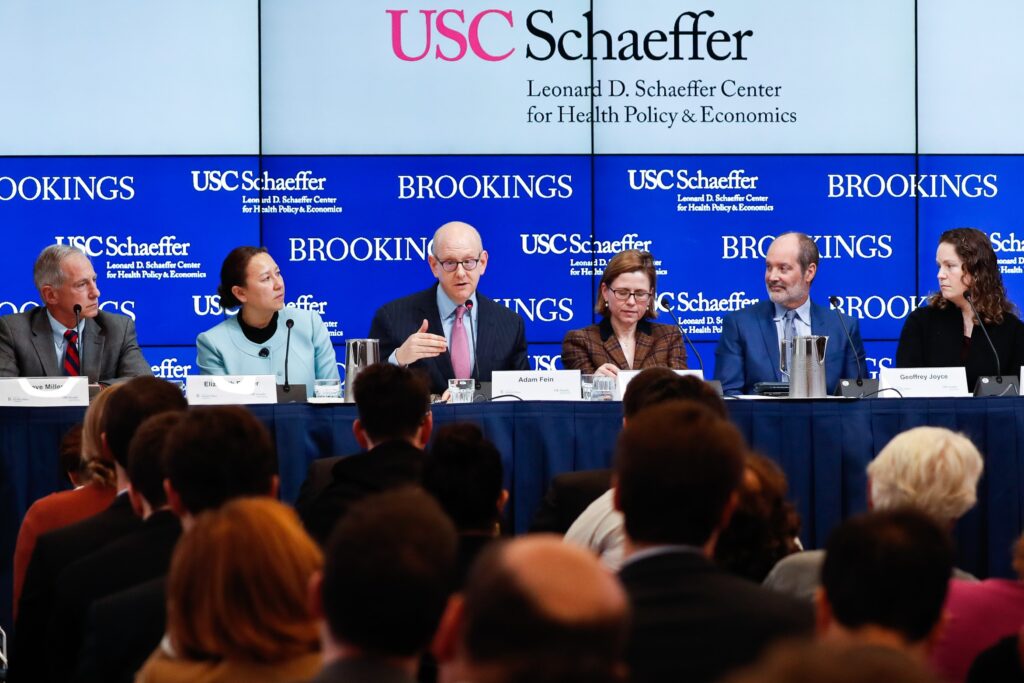
Getting It Right: Drug Pricing Reform That Works for Patients and the Medicare Program
October 14, 2022
Schaeffer Center and the Alliance for Aging Research hosted a conversation on the current proposals to reform drug pricing.
Drug Rebates in Medicare Part D
July 27, 2021
The USC-Brookings Schaeffer Initiative for Health Policy hosted a webinar to discuss how the increasing reliance on rebates burdens many Medicare patients and discuss policy solutions.
Patient Cost-Sharing for Prescription Drugs: Policy Issues
February 16, 2018
The USC-Brookings Schaeffer Initiative for Health Policy hosted a conference on the policy issues surrounding patient drug cost sharing. Two panels convened, first to discuss restructuring the Medicare Part D benefit design, and then to debate the effectiveness of mechanisms to reduce cost sharing for commercially insured patients.
Fostering Competition in the Pharmaceutical Distribution Chain
June 14, 2017
The USC-Brookings Schaeffer Initiative for Innovation in Health Policy hosted a forum to explore the many segments of the drug distribution chain and examine proposals to reduce price markups through increased competition.
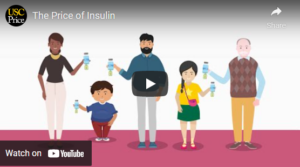
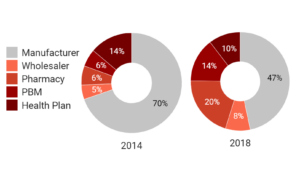
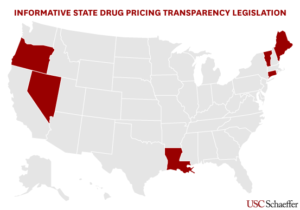
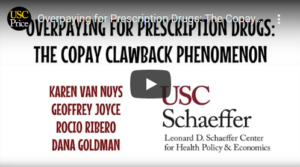
You must be logged in to post a comment.